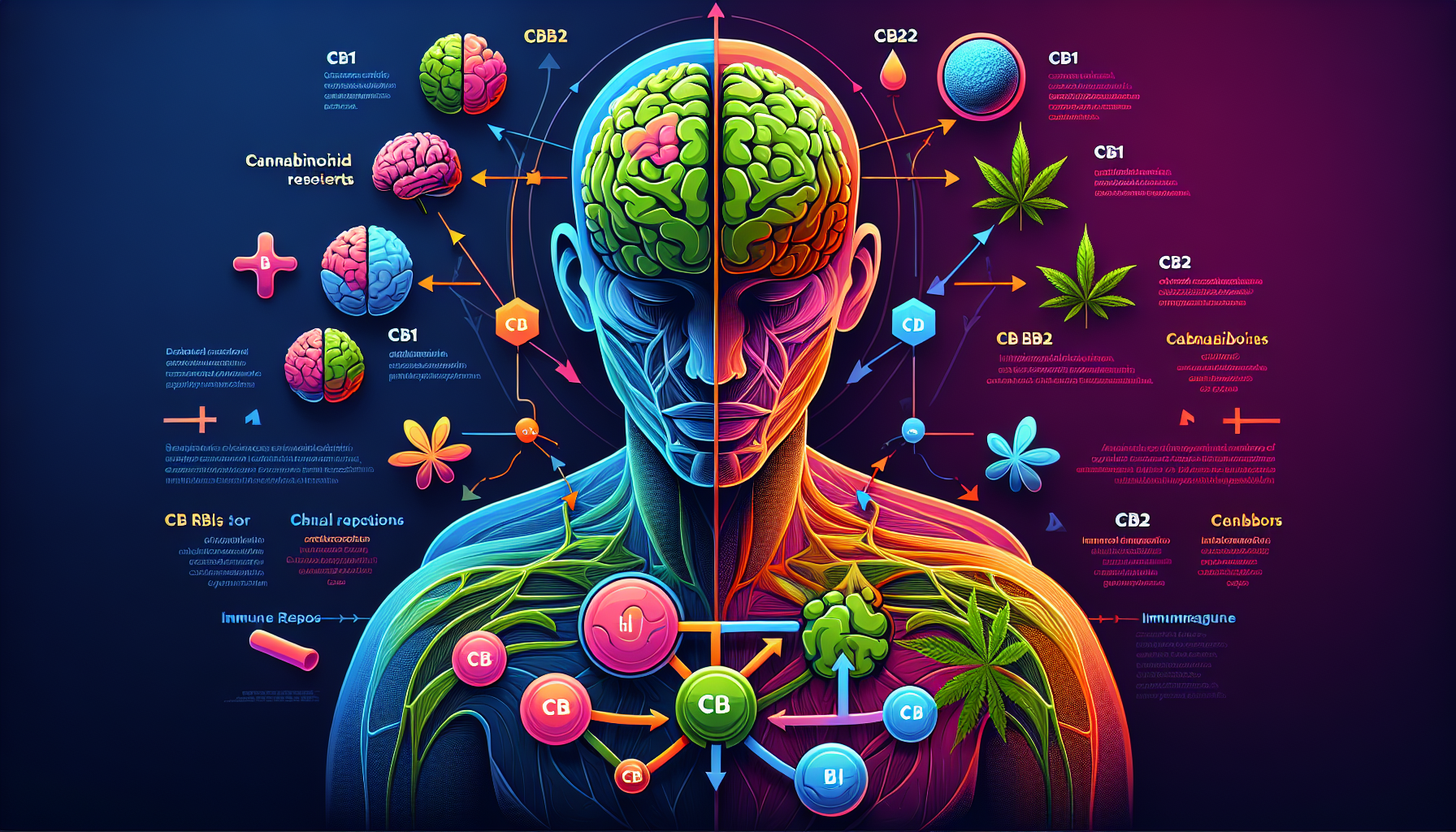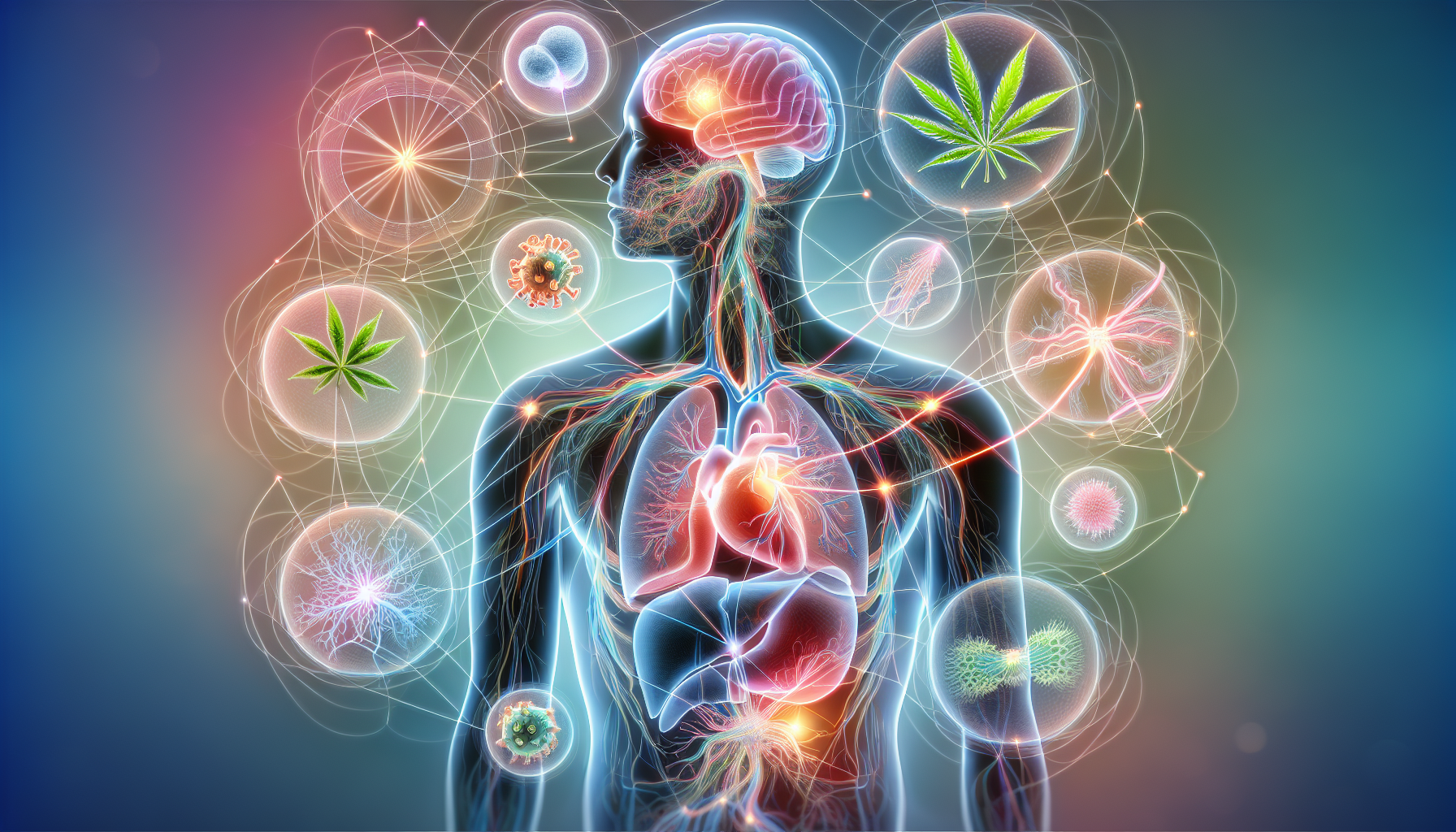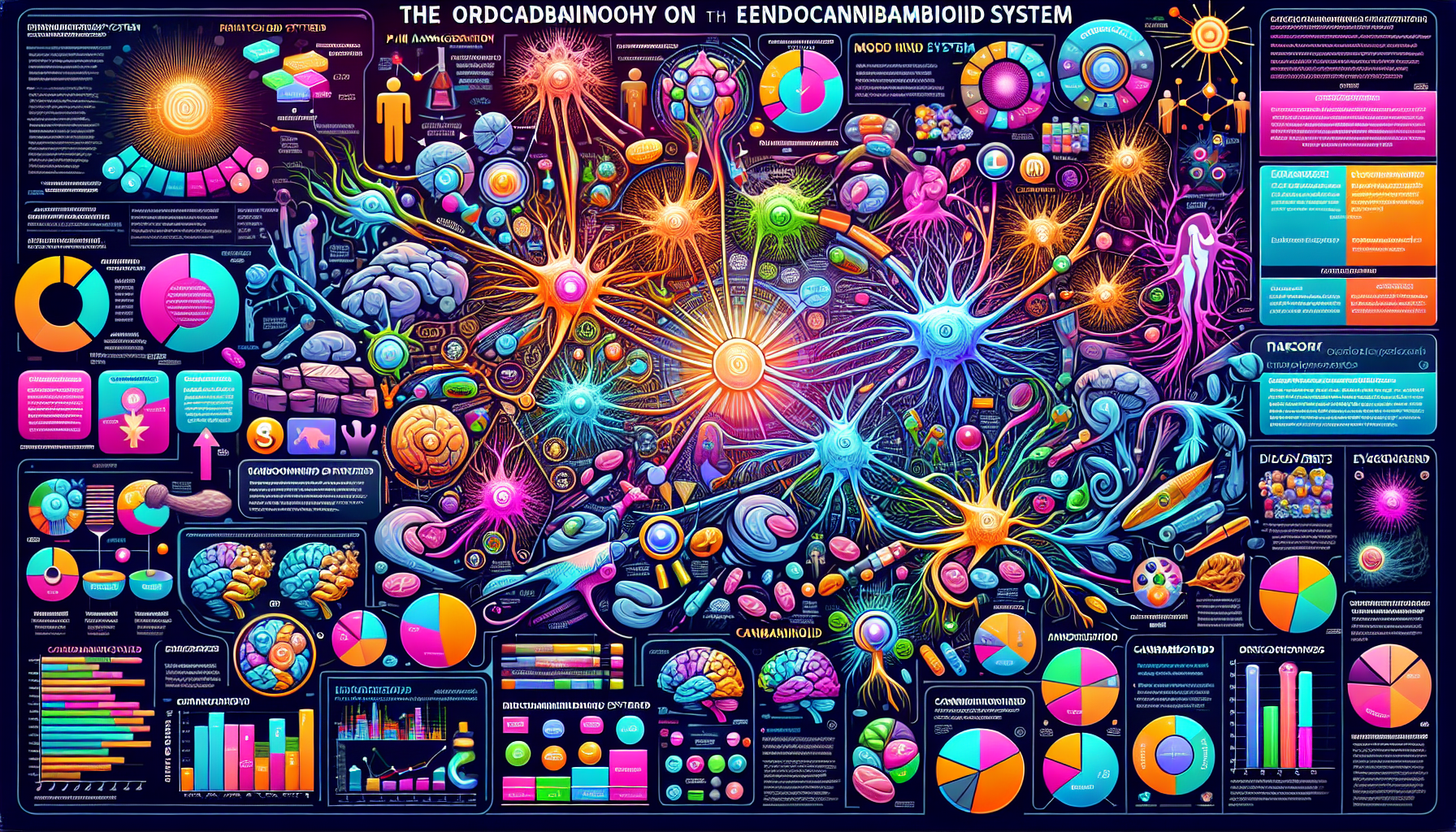The Endocannabinoid System: The Best for Your Well-Being
The endocannabinoid system (ECS) is a biological system in the body that regulates many physiological processes such as pain, mood and sleep. The endocannabinoid system simply explained: It consists of receptors that react to both the body's own (endogenous) and plant-based (exogenous) cannabinoids. The cannabinoid receptors CB1 and CB2 play a central role in this by influencing various bodily functions. In this article we explain what the endocannabinoid system is, how it works and why it is important for well-being.
The most important things at a glance
-
The endocannabinoid system is an important communication network that controls numerous physiological processes in the body by interacting with endogenous and exogenous cannabinoids. The endocannabinoid system was discovered when researchers were studying how cannabis works in the human body. It consists of cannabinoid receptors, endocannabinoids, and enzymes responsible for the synthesis and degradation of these molecules. Further research is needed to fully understand the complex mechanisms and the role of phytocannabinoids in this system.
-
The main components of the endocannabinoid system are the cannabinoid receptors CB1 and CB2, which are present in various organs and tissues and play crucial roles in pain regulation and immune response.
-
CBD can support the endocannabinoid system by increasing the availability of endocannabinoids and inhibiting their degradation, thereby potentially promoting overall well-being.
What is the endocannabinoid system?

The endocannabinoid system (ECS) is a fascinating communication network that influences a variety of physiological processes in the body. It works according to the key-lock principle, with cannabinoid receptors acting as locks and cannabinoids as keys. This system is present not only in the brain, but also in the entire nervous system of all mammals and is therefore also called the endogenous cannabinoid system.
The ECS interacts with both endogenous and exogenous cannabinoids to promote well-being. Endogenous cannabinoids produced in the human body interact with specific receptors and have a variety of functions in the nervous system. This interaction affects the immune system and other important bodily functions. To fully understand the ECS, it is important to know its discovery history and main components.
discovery of the endocannabinoid system
The history of the endocannabinoid system is closely linked to the study of the cannabis plant. In the 1980s, intensive research led to the discovery of the ECS and its receptors by scientists. This discovery was about twenty years after the identification of THC, the psychoactive component of cannabis.
Scientific proof of the endocannabinoid system finally came in the 1990s. One of the groundbreaking discoveries was the identification of anandamide, a cannabinoid produced by the body, by renowned researcher Raphael Mechoulam and his team. These discoveries have significantly expanded our understanding of health and disease.
components of the endocannabinoid system
The endocannabinoid system consists of several essential components: receptors, cannabinoids, and enzymes. The endocannabinoid system includes the CB1 and CB2 receptors, which regulate various physiological processes, as well as endogenous cannabinoids such as anandamide and 2-AG, which act on these receptors. These receptors are distributed in many parts of the body and play a crucial role in signal transmission in the body.
Endocannabinoids such as anandamide and 2-AG act on the same receptors as plant cannabinoids and are central to signaling in the body. These molecules are synthesized as needed and are not stored in the body.
Enzymes such as FAAH and MAGL are crucial for the breakdown of endocannabinoids and help regulate the effects of these messengers in the body. These enzymes ensure that the endocannabinoids remain active only for as long as they are needed, thus helping to maintain balance in the body.
The role of cannabinoid receptors

The cannabinoid receptors CB1 and CB2 are the main players in the endocannabinoid system. They are distributed throughout the body, including glands, immune cells, and the gastrointestinal tract. A common misconception is that these receptors are exclusively present in the brain, but they are actually found in many different organs and tissues.
CB1 receptors are mainly located in the nervous system and influence functions such as pain regulation and appetite control. Some CB2 receptors, on the other hand, are mainly found in the immune system and play a role in the immune response and anti-inflammatory effects. These receptors are crucial for the diverse effects of the ECS.
CB1 receptor
The CB1 receptors are mainly located in the brain. However, they are also present in other organs such as the kidneys and intestines. Particularly high concentrations of these receptors are found in the basal ganglia, the cerebellum and the hippocampus.
These receptors control important functions such as appetite and pain regulation. Endocannabinoids such as anandamide and 2-AG act as retrograde synaptic messengers and provide feedback to pre-synaptic neurons via the CB1 receptors.
CB2 receptor
CB2 receptors are mainly found in the immune system and on cells of the central nervous system. They play an essential role in the immune response and in the inhibition of inflammation. Endocannabinoids such as anandamide and 2-AG are produced when needed and bind to these receptors.
2-AG has a stronger effect on the CB1 and CB2 receptors than anandamide and therefore plays an important role in the regulation of immune processes and inflammation.
Endocannabinoids: Natural Messenger Substances

The best known endogenous cannabinoids are anandamide and 2-AG. Anandamide acts primarily on the CB1 receptor and influences a variety of bodily functions such as mood and pain perception. 2-AG binds to the CB2 receptors and plays an important role in the immune response.
Endocannabinoids are synthesized in the body as needed and are not stored. Synthesis occurs in response to increased calcium concentrations, which ensures that these molecules are only produced when they are really needed.
The well-known endocannabinoids such as anandamide and 2-AG are synthesized from arachidonic acid. This fatty acid belongs to the group of omega-6 fatty acids. These natural messengers are crucial for the smooth functioning of the ECS and contribute significantly to maintaining homeostasis.
Exogenous Cannabinoids and their Effects
Exogenous cannabinoids such as THC and CBD come from the cannabis plant and can influence the endocannabinoid system. THC binds to CB1 receptors and influences cannabinoid-controlled processes, resulting in various physiological effects. This interaction can modulate functions such as pain perception and appetite regulation.
CBD, another exogenous cannabinoid, has diverse effects and can affect the ECS in several ways. It does not interact directly with the CB1 or CB2 receptors, but can increase the availability of endocannabinoids in the body and thus promote well-being.
Differences between THC and CBD
THC and CBD, the two most well-known cannabinoids, differ significantly in their effects. THC has psychoactive properties, which means it can alter consciousness and perception. CBD, on the other hand, is considered non-psychoactive and does not have an intoxicating effect.
Legal regulations for THC and CBD vary around the world. While CBD is legal in many countries, THC is subject to strict regulations in many regions. These differences affect how and where these substances can be used.
How the Endocannabinoid System Supports Homeostasis

The endocannabinoid system plays a crucial role in regulating numerous body functions and actively contributes to maintaining internal balance. It responds to imbalances in the body by synthesizing endocannabinoids, which dock onto receptors and send signals to restore balance.
The ECS influences the immune system by modulating inflammatory responses and thus contributing to homeostasis. Cannabinoid receptors are present in many organs of the body and influence numerous physiological processes, including pain sensation, appetite regulation and memory.
Both endocannabinoids, anandamide and 2-AG, can modulate the release of neurotransmitters in the brain, helping to regulate mood and behavior. CBD can increase the availability of endocannabinoids in the body by inhibiting their breakdown.
Current research on the endocannabinoid system

Current research on the endocannabinoid system shows promising results. There is evidence that CBD has neuroprotective properties, making it relevant for the treatment of neurological disorders. However, treatment with cannabinoid-containing medications shows mixed results, especially for mental disorders.
CBD is also being studied for its potential to treat mental illnesses such as schizophrenia and depression. Dysfunction of the endocannabinoid system may be linked to mental illnesses such as anxiety disorders, depression and schizophrenia.
Alterations in the endocannabinoid system are being investigated as potential biomarkers for the diagnosis and prognosis of mental illnesses. This research could open new avenues for the treatment and understanding of these complex disorders.
Possible disorders of the endocannabinoid system
The endocannabinoid system plays an important role in adapting to stress and emotional responses by regulating mood and anxiety. Dysfunction of this system can therefore lead to significant health problems. This is reflected, for example, in the fact that CBD is often used to relieve stress and anxiety due to its calming effect.
A lack of endocannabinoids is considered a possible factor in the development of certain chronic pain. The use of CBD can help reduce pain by modulating pain signals in the body. CBD has also been shown to have anti-inflammatory properties that can be beneficial for various conditions.
Different effects on the ECS depend on factors such as the number of cannabinoid receptors. For example, blocking CB1 receptors can cause severe anxiety disorders, while CB2 receptors play a role in immune defense. Chronic THC use, on the other hand, can lead to permanent cognitive impairment.
Using CBD to Support the Endocannabinoid System
CBD works through the endocannabinoid system and influences well-being. It can increase the availability of endocannabinoids in the body by inhibiting their breakdown or by supplying plant-based cannabinoids. This leads to better regulation of body functions and can promote general well-being.
CBD can trigger different reactions that promote well-being and relaxation. It does not replace the body's own cannabinoids, but rather complements and supports the existing system. The use of CBD therefore offers a natural way to support the endocannabinoid system and promote internal balance.
Summary
The endocannabinoid system is a fascinating and complex network that plays a crucial role in our well-being. It regulates numerous bodily functions and actively contributes to maintaining homeostasis. The cannabinoid receptors CB1 and CB2 are of central importance and influence various physiological processes.
Current research shows promising approaches, especially with regard to the use of CBD to support the ECS. The diverse effects of CBD, its neuroprotective properties and the potential application in mental illnesses open up new perspectives. By better understanding and specifically supporting the endocannabinoid system, we can sustainably improve our well-being.
Frequently Asked Questions
What is the endocannabinoid system?
The endocannabinoid system (ECS) is an important communication network in the body that controls various physiological processes, including pain regulation, appetite control and immune response. It plays a crucial role in the balance and well-being of the organism.
How was the endocannabinoid system discovered?
The endocannabinoid system was discovered in the 1980s when cannabinoid receptors were identified, and anandamide was researched by Raphael Mechoulam in the 1990s. These discoveries have greatly expanded the understanding of cannabinoid action in the body.
What are the main components of the endocannabinoid system?
The main components of the endocannabinoid system are the receptors CB1 and CB2, the endogenous cannabinoids anandamide and 2-AG, and the enzymes responsible for breaking down these messengers. These components work together to regulate various physiological processes in the body.
What is the difference between THC and CBD?
The key difference between THC and CBD lies in their effects: THC is psychoactive and affects consciousness, while CBD is non-psychoactive and has no intoxicating effects.
How can CBD support the endocannabinoid system?
CBD can support the endocannabinoid system by inhibiting the breakdown of endocannabinoids and increasing their availability, which contributes to improved well-being and better regulation of body functions.

Share:
Top HHC products in the HHC Shop | Quality and discreet shipping
Cannabidiol fruit gums in the test: The best products for your well-being!